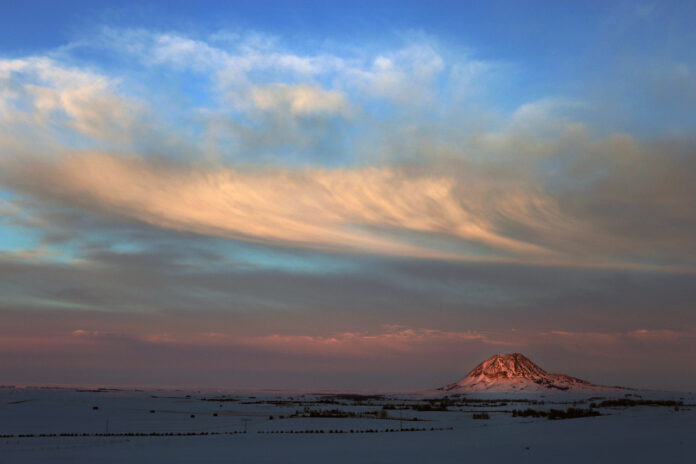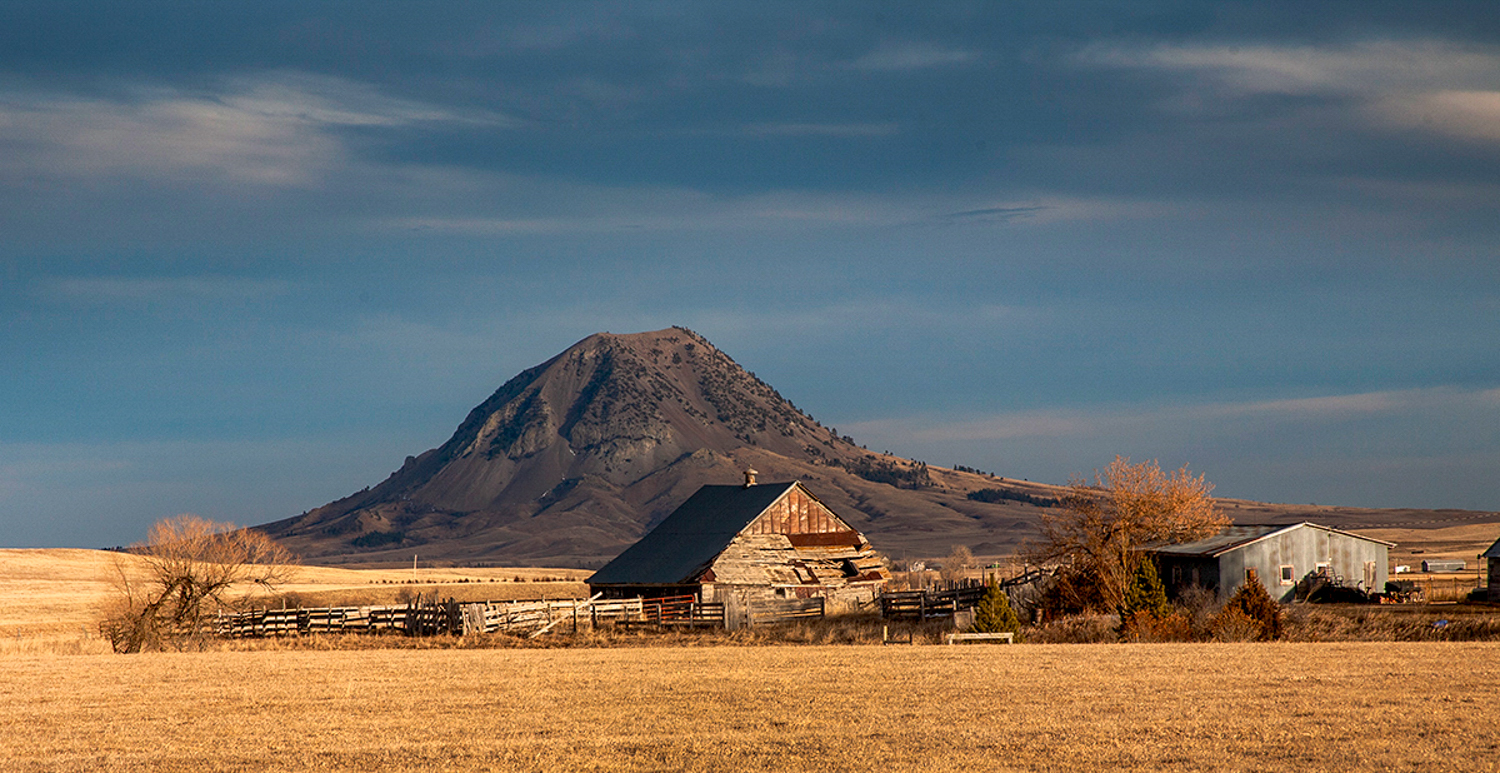Drive the northern edge of the Black Hills and you can’t miss it: a solitary, steep-sided mountain rising from open prairie like a lifted knuckle. This is Bear Butte—Matȟó Pahá to the Lakota; Noahȧ-vose (also Náhkȯhe-vose) to the Cheyenne—a place where geology, memory, and modern life collide. Just outside Sturgis, South Dakota, it’s both a state park and a living sanctuary, instantly recognizable to anyone who’s ever rolled through the Sturgis Motorcycle Rally. It’s also one of the most storied landmarks in the Northern Plains, a site of councils and prophecy, prayer and protest, and the kind of views that once helped travelers spot four states on a clear day.
Geologically, Bear Butte isn’t a volcano but a laccolith—a body of magma that pushed up under older sedimentary layers and domed the overlying rock without breaking the surface. Over tens of millions of years, erosion stripped away those softer layers and left the hardened igneous core standing proud above the prairie. In the regional story of the Northern Black Hills Igneous Province, Bear Butte is book-ended by kin like Devils Tower and the Missouri Buttes to the west. Most of these intrusions crystallized between roughly 58 and 50 million years ago. The result is that classic craggy profile—ribbed slopes, talus aprons, and blocky outcrops—that reads like a geological exclamation point.
At 4,426 feet, the butte rises more than 1,200 feet above the surrounding grasslands, a topographic island with sweeping 360-degree sightlines. The summit trail is a straightforward out-and-back climb, about 3.2 miles round-trip, and a reminder that a “short hike” on the plains still earns long horizons. On most days the wind is your companion; on the best days you’ll watch cloud-shadow waves move like water over the wheat-colored prairie.
A Sacred Mountain, Then and Now
Long before there was a state of South Dakota—long before there was a United States—Bear Butte was a place of instruction and encounter. For the Lakota, Matȟó Pahá is a sacred bear and a sentinel; for the Cheyenne, Noahȧ-vose is “the place where the Cheyenne are taught.” Cheyenne oral histories hold that Sweet Medicine, the culture-bringer and prophet, received laws and ceremonies here—religious, political, social, economic—teachings that shaped a people. Pilgrimage continues: prayer cloths and tobacco ties flutter from branches along the approach, and quiet camp circles appear at the base during ceremony seasons. Visitors are asked to leave offerings undisturbed and keep their voices low.
The state recognized the site’s significance by creating Bear Butte State Park in 1961, and the federal government later listed it as a National Historic Landmark in 1981, formal nods to what tribal nations already knew: this is no ordinary hill. It is a place to fast, to “cry for a vision,” and to receive instruction—practices that go on, quietly and purposefully, whether anyone else is watching or not.
Where Nations Met
History here isn’t written only in stone; it’s braided through councils and commitments. As pressure mounted from the United States in the mid-19th century, leaders gathered at Bear Butte to debate how to respond. Records note a major Lakota council in August 1857 at Matȟó Pahá to address settler and military incursions—one of several moments when the butte functioned as a diplomatic table under the sky. Another gathering was held in 1867 as tensions and treaty disputes accelerated toward the Great Sioux War. Whether 1857, 1867, or both, the pattern is clear: when stakes were existential, people met at Bear Butte.
Because the butte sits astride the approaches to the Black Hills, it was also a guidepost for non-Native travelers, trappers, and soldiers. Accounts from the 19th century often describe it as the first “sentinel” of the Hills visible from the east—an unmistakable shape announcing that a different kind of country lay ahead.
Eight Miles—and a World—from Sturgis
Geography guarantees that sacred land and secular spectacle will sometimes share a fence line. Bear Butte is about eight to eight-and-a-half miles from Sturgis, and during the annual motorcycle rally, hundreds of thousands of visitors flood nearby campgrounds and concert venues. That proximity has brewed a long-running debate about noise, traffic, and alcohol-fueled nightlife rubbing against ceremonies that require reverence, fasting, and silence. Tribal and advocacy groups have argued for meaningful buffer zones and tighter licensing; county boards have at times renewed liquor licenses for large bars near the butte, prompting protests and prayer marches. The friction isn’t theoretical—you can stand on the slope during summer and hear the bass line from a stage down the road.
Inside the park boundary, the state tries to hold a line. Because Bear Butte is an active place of worship, alcohol possession and consumption are prohibited on the east side of Highway 79, and official guidance emphasizes respect for offerings and ceremonies encountered along the trail. For many visitors, that’s the first practical lesson about this landscape: stewardship here isn’t just about not littering; it’s about understanding that you are walking through someone else’s living sanctuary.
Reading the Landscape
Spend time on the mountain and you start to see how its form shaped its uses. The ribs and gullies catch the wind differently; there are quiet pockets perfectly sized for a single person to sit, fast, and watch the sky change. Those same ridges serve as natural “aisles,” gently channeling foot traffic toward the crest. The long view matters, too. From the summit, the grasslands feel endless, but the Black Hills pull the eye like a dark tide. That vista helps explain why Bear Butte served as a waypoint, a council ground, and a spiritual classroom. Place matters because perspective matters; a horizon like this makes people think in generations, not seasons.
Science and Story in the Same Place
Some sites force a false choice between science and story. Bear Butte refuses that split. The same igneous core that thrills a geologist also grounds Cheyenne teachings; the same erosional ramparts that interest a geomorphologist provide privacy for someone in prayer. In the broader igneous province, Bear Butte is part of a chain of shallow intrusions that never quite erupted—an anatomy lesson in how magma stagnates, cools, and hardens near the surface. For Indigenous nations, it is where law and ceremony were given, where leaders sought visions, and where commitments were renewed. Both truths rest on the same ground.
The Modern Edge
Like many sacred places ringed by modern development, Bear Butte sits in a legal and cultural crosswind. Efforts by tribes to purchase nearby lands and strengthen protections have grown in recent years, part of a wider push to conserve sacred sites in and around the Black Hills. Meanwhile, tourism marketing touts the hike and the views, bikers continue to pack the county in August, and land-use decisions ripple far beyond their parcel lines. If you’re visiting, the ethics are simple: learn the names, mind the rules, and remember that what looks like open country might be a church.
If You Go
Bear Butte State Park is a quick drive from Sturgis. The trail is exposed—bring water, check the wind, and give yourself time. You’ll pass offerings on the way up; don’t touch them. Keep conversations low. Photography is fine on the trail and summit, but be mindful if ceremonies are underway. Save the beer for later—again, alcohol is prohibited in key areas of the park—and treat the place like you would any sanctuary: with attention, humility, and a willingness to let it work on you.
About Buck Lovell
Buck Lovell was more than a colleague—he was our friend. In 2023, we lost him to PTSD, and mental illness. Buck was a gifted nature and landscape photographer from Deadwood, South Dakota, and he contributed his talents to Trails West Magazine for many years. Among his favorite subjects was Bear Butte, a place he returned to time and again with his Nikon and Cannon cameras, capturing its changing light at nearly every hour of the day. Today, Buck’s images can be purchased at Jacobs Gallery in Deadwood, South Dakota, where his widow, Traci, continues to honor his legacy.
- Geology and age: Bear Butte as an Eocene laccolith; regional intrusive context (58–50 Ma)
- Elevation, views, and park overview
- Trail distance and hiking note
- Sacred status, names, and ongoing offerings/practice
- Historic councils (1857; further 1867 reference)
- “Sentinel” landmark to early travelers
- Sturgis proximity and development/venue context
- Liquor-license controversy near the butte
- Alcohol prohibition and respectful-use rules within the park









